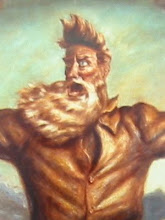In the area where I live there is a lot of emphasis placed on wild-land firefighting. Most departments have at least minimal wild land firefighting capability and many have a significant capability, both in equipment and apparatus.
Many agencies have specialized engines for fighting wildfire or fighting fire in the urban - wildland interface. While out and about the other day, I snapped some photographs of some of these specialized units.
This is a Type 1 engine, which means that it's pump capacity, water tank capacity and equipment inventory meets the requirements for a structural firefighting. This engine is unique in that it was designed to operate in the urban-wildland interface, that is areas where a community is located in or amid large wild-land threats. Features that facilitate use in the interface include short wheelbase, increased ground clearance, higher angle of approach and departure, tighter turning radius and a separate diesel powered axillary fire pump. Note the skid protection under the front bumper.
All of these features make it better equipped to handle under-improved roads, long narrow driveways and other areas where the "pavement queens" dare not go. These are a relatively new concept in the fire service, but are gaining popularity, especially in communities with a high interface risk.
This is a Type-3 engine that is designed for wildland firefighting. It carries minimal if any structural firefighting equipment, depending on the interface risk. It has a smaller main pump and is not required to carry ladders or structural supply hose. This particular unit is four wheel drive, and has a higher ground clearance and shorter wheelbase than the unit above. It too has a separate diesel powered axillary pump which gives it true pump and roll capability.
They carry a large amount of wild land hose, usually at least 1000' of 1 1/2" single jacket. Hose lays exceeding 3000 - 4000 feet are not unheard of, with all of it being packed in on someones back. The basic wildland hose lay evolution is simple yet highly efficient. A crew well practiced in it is a joy to watch.
This is a water tender. Known as a tanker in other parts of the country, it's sole purpose is to provide water to engines when operating at a wildland fire. They usually carry only enough hose for a protection line and very little equipment. This one is rather small, which makes it more suitable to dirt roads, fields and trails. It holds 1500 gallons of water, just about enough to fill three engines. These units are extremely valuable in areas where water supplies are scarce and are always being called out to assist other agencies.
This is a crew bus, it's job is to transport hand crew, their foreman and their equipment to the fire. A hand crew consists of 12 to 20 firefighters who use chainsaws and hand tools to create fireline. It is grueling, hard work. This particular crew is an inmate crew, one who's members are in state prison and who serve their sentences working on a crew. Cal-fire relies heavily on inmate crews, most if not all Cal-Fire crews are inmates. Other agencies have inmate and non-custodial hand crews.
Typically, it is the hand crews who work the hardest on large wildfires, their work continuing long after the fire is out.
On the fireline, an inmate's personal protective equipment will be orange. those in yellow are not. In this photo, the guy in yellow is the crew supervisor. Strict rules are in place about interacting with inmates, contact with them is prohibited. Issues with inmates a relatively rare, as it is a privilege for them to be on a crew.One bad word from the supervisor and the inmate is back inside. On extended incidents, a prison guard will be present as well, though the guard usually does not go on the line.
As fire season progresses, I will likely have more pictures to share. Hope your weekend goes well.
Thanks for reading,
Schmoe







Interesting pictures! Thanks for sharing!
ReplyDeletexx
Jaxs
Nice post, thanks, learn something new. Imate crews? well at least the state is getting something back from the prisons. At on time the state of Texas prison system was making money on all the factories and farms they had, now, it is costing money because most of those programs were shut down and the prisoners just hang out. It needs to go back to the old days and this is a really good way.
ReplyDeleteTHANK YOU for posting. You site rocks!!!
ReplyDeleteSteve
Common Cents
http://www.commoncts.blogspot.com
thanks for sharing, love your blog and your pictures
ReplyDeleteCapt Schmoe:
ReplyDeleteI do love me some fire trucks ! Thanks for the pictures and have a safe wild fire season.
The Observer
Dear Captain Schmoe,
ReplyDeleteI love your explanations of the truck specifications as to wheelbase, size, turning capability. You used the word 'evolution' and seems very apt in this post. I was reminded of Darwin's finches.
You are a good teacher. I always learn so much in such delightful small packages.
Sincerely,
Ann T.
TGR - Yeah, the state gets their money's worth out of these inmates. The earn $1.45 a day for working on "projects" plus $1.00 an hour when assigned to a fire.
ReplyDeleteA bargain for sure.
All - I'm glad you enjoyed the pics. I forgot one that I will have to post at a later date.
Thanks for reading.
Captain Schmoe,
ReplyDeleteRaising my hand:
You said that some vehicles have a higher "angle of departure?" What's that?
What is a protection line?
Thanks for writing!
Thanks for posting this. I learned a lot and enjoy looking at the fire trucks.
ReplyDelete